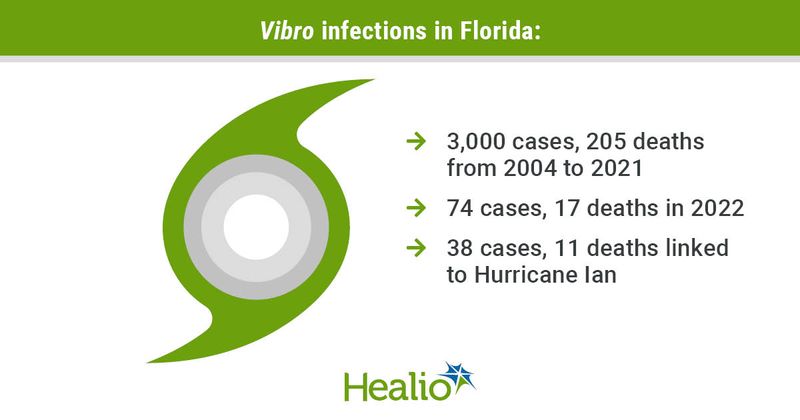Infection
Vibrio cases, deaths in Florida doubled after Hurricane Ian
October 27, 2023
3 min read
Key takeaways:
- Twelve species of Vibrio were found in water and oyster samples after Hurricane Ian, including V. vulnificus.
- The increase in pathogens in coastal waters has been linked to climate change.
Vibrio cases and deaths in Florida spiked last year after Hurricane Ian, lending credence to concerns that larger, longer, warmer tropical storms may increase the risk for viral infections, according to a study.
Researchers detected several pathogenic Vibrio species in water and oyster samples from Lee County, a coastal region of southwest Florida, including Vibrio parahaemolyticus and Vibrio vulnificus. The number of cases attributed to Hurricane Ian, a category 5 storm, were double what would normally be expected for that time of year.
“We were surprised to be able to detect — without any difficulty — the presence of these pathogens,” Rita R. Colwell, PhD, an environmental microbiologist and distinguished university professor at the University of Maryland Institute for Advanced Computer Studies, said in a press release.
There are roughly 80,000 cases of vibriosis each year in the United States, with more than 50,000 linked to eating contaminated food — generally raw or undercooked shellfish, specifically oysters — according to the CDC. Certain Vibrio species found in salt water or brackish water can also cause a skin infection if an open would is exposed to either water type.
Most of these infections, according to experts, are reported on the East Coast and Gulf Coast of the U.S. Between 2004 and 2021, more than 3,000 vibriosis cases and 205 deaths were reported in just Florida, according to the authors of the new study.
Although most people recover from a mild Vibrio case in a few days, infection with V. vulnificus — sometimes referred to as a flesh-eating bacteria — can cause serious illness, or even limb amputation. One in five people infected with V. vulnificus die of the infection.
Warming waters off the country’s East Coast and Gulf Coast have been linked to increased detection of Vibrio species and an increase in infections and deaths for more than a decade. In September 2023, the CDC issued a health advisory for these parts of the country after severe heat waves in the preceding weeks and an increased rate of infections of V. vulnificus.
Colwell and colleagues analyzed water and oyster samples from three stations in Lee County, Florida, in October 2022, weeks after Hurricane Ian made landfall in the Fort Myers area of Florida’s Gulf Coast on Sept. 28, 2022, leading to catastrophic storm surge and extreme rainfall. The storm “exemplified the more intense, slower-moving and wetter signature” among Atlantic hurricanes in recent years that has been influenced by climate change, the researchers wrote.
Analysis of the water and oyster samples revealed 12 pathogenic Vibrio species, including V. parahaemolyticus and V. vulnificus, showing a potential increased risk for infections following the storm. This matched up with statistics from the Florida Department of Health, which reported 74 V. vulnificus infections and 17 deaths, of which 38 cases and 11 deaths were specifically attributed to the storm and its aftermath — double the number of cases and deaths officials would expect to see during that time, according to the study.
Colwell and colleagues concluded that changing climate conditions may increase pathogenic presence in waterways or standing water in the event of flooding, and understanding the environmental effects of large storms could help prevent some infections.
“On the positive side, knowing that these infections are associated with the increased variability of a changing climate, perhaps now is the time to develop mechanisms to understand and mitigate it,” Colwell said. “Climate change and flooding are clearly linked to infectious disease, and we need to take it seriously.”
References:
Sources/Disclosures
Collapse
Disclosures:
Colwell reports no relevant financial disclosures. Please see the study for all other authors’ relevant financial disclosures.


